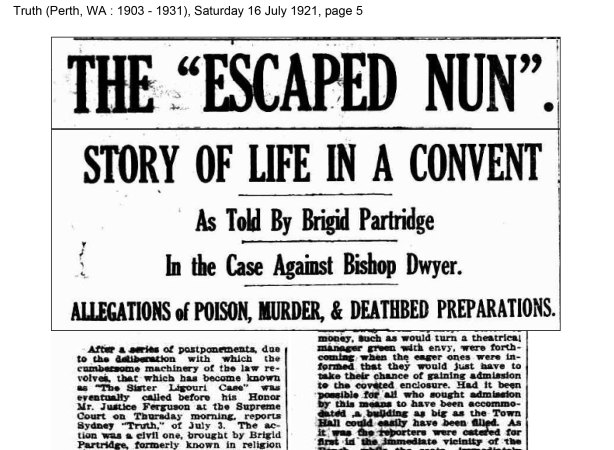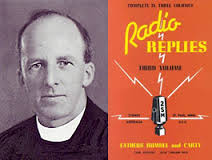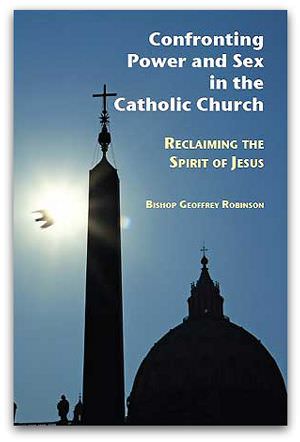Page Contents
The Catholic Church prides itself on its unity. It is established on the principle that love is the highest virtue. But, like any large organisation of people, it is inevitably subject to controversies, splits, ructions and scandals. Conflicts both internal and external have been frequent. Much as official policy might enjoin “avoidance of scandal”, that is not going to happen.
Fr O’Flynn and Macquarie
In 1817 Fr Jeremiah O’Flynn arrived in Sydney, then without any Catholic priests. He claimed falsely that documents giving him permission to be there would follow later. When it became clear that he had no permission, Governor Macquarie deported him. The story is told in Paul Collins’ A Very Contrary Irishman. Later Australian Catholics often took this to be a case of religious persecution, but it is now generally agreed that is not correct (although Macquarie did prefer uniformity of religion).
Benedictines and Irish
Although the majority of early Catholics and the first priests were Irish, by the 1830s government policy favoured an English-led church and the first two Archbishops of Sydney, Polding and Vaughan, were English Benedictines. They hoped to form the Australian Church in a Benedictine monastic mould.
Tensions arose between English leaders and Irish clergy and people. The story of the leader of the Irish “faction” is told in Edmund Campion’s ‘Archdeacon John McEncroe: An architect of the Australian Church‘, Journal of the Australian Catholic Historical Society 39 (2018).
The English Benedictine ascendancy ended with the death of Archbishop Vaughan in 1883. By then Vatican policy for Anglophone countries was controlled by Cardinal Cullen, who appointed his nephew, Francis (later Cardinal) Moran as Archbishop of Sydney. He and other Irish bishops transformed the Australian Church into an Irish-led organisation until 1940.
Mary MacKillop’s excommunication
For a saint, Mary MacKillop experienced an unusual amount of conflict. She was excommunicated for “insubordination” in 1871 but the decision was reversed the next year. Conflict with bishops continued over who would have control over the nuns, the superior of the order or the local bishop. In 1873-5 she visited Rome and gained qualified approval for her plan of central government. The Bishop of Bathurst demanded control in his diocese, leading to a split and the formation of the “black” sisters under local control. For similar reasons, the Bishop of Brisbane (brother of the Bishop of Bathurst) expelled the Sisters from Queensland in 1880.
The Roman decision also enforced a less rigorous poverty than MacKillop wished, which her co-founder Julian Tenison Woods regarded as a betrayal of the order’s vision; the rift between the two never fully healed.
In 1883 the Bishop of Adelaide demanded MacKillop leave. In 1885 Cardinal Moran informed MacKillop that her re-election as Superior General was invalid and appointed a replacement.
Protestant-Catholic sectarian divisions
British Protestant immigrants to Australia brought suspicions of Catholicism going back to the Reformation, while Irish Catholics brought resentments over persecution in Ireland.
In the late nineteenth century, lecturing on the evils of Catholicism could provide a useful income for ex-priests, as described in Colin Fowler’s ‘“Like Waterloo survivors”: ex-priests and the nineteenth-century Australian press‘, Australasian Catholic Record 96/2 (2019).
“No Irish need apply” signs were occasionally found in job ads in the mid-nineteenth century and less overt discrimination occurred up to about 1960. Freemasons, though not explicitly anti-Catholic, favoured one another in employment so de facto disfavoured Catholics. But Orangeism, which is explicitly anti-Catholic, was never strong in Australia. Although Australia had the ethnic composition of Ulster, restraint on both sides avoided the troubles of that region.
Catholic reaction was occasionally boisterous, such as by the mob at Maitland in 1860 who prevented a lecture on “the heathenism of popery”. Mostly it involved peaceful long-term organisation, such as by the Knights of the Southern Cross who fought for Catholic rights in employment. Political parties such as the Catholic Federation were unsuccessful but the Labor Party became in some places heavily Irish Catholic (see the page on Irish Catholic Australians)
Conflict arose during the Boer War, with some Catholic priests of Irish background opposing Australia’s involvement.
In 1900 Cardinal Moran’s private secretary, Fr Denis O’Haran was named as co-respondent in a divorce case. After litigation accompanied by sectarian conflict, a jury found in his favour but doubts remained.

A sectarian cause célèbre began with the flight of Sister Liguori (b. Bridget Partridge, Co. Kildare, 1890) from the Presentation Convent, Wagga, in 1920. She lodged with a Protestant minister and subsequent court cases inflamed sectarian bitterness. The story is told in Maureen McKeown’s The Extraordinary Case of Sister Liguori. (video lecture)
One cause of tension was Catholic opposition to “mixed marriages” (between Catholics and non-Catholics). The future prime minister, Ben Chifley, was automatically excommunicated for marrying in a Presbyterian church in 1914. NSW legislation to forbid the promulgation of the papal marriage decree Ne temere was defeated by two votes in 1924.
Ultra-Protestant anti-Catholic polemics were pursued by Dill Macky’s The Watchman (1902-26; archive) and Wal Campbell‘s weekly paper, The Rock, published from 1945.

(Missionaries of the Sacred Heart)
Radio listeners in the mid 20th century were familiar with the “voice like worn sandpaper” of Dr Rumble, whose Question Box program answered rationally a host of questions on faith and morality sent in by often hostile listeners, many of them Protestants. Written collections of his answers were popular in the US and said to have sold seven million copies. A later work of the same kind was Paul Stenhouse‘s Catholic Answers to “Bible” Christians.
State aid for church schools
Catholic education faced opposition from those who thought it promoted superstition. The Rev Samuel Marsden about 1807 hoped that Catholicism would soon die out if children were all educated at non-Catholic schools, while Henry Parkes in 1851 called for action against the “grovelling superstition which seeks to fetter and degrade.” In turn Archbishop Vaughan called state schools “seedplots of future immorality, infidelity and lawlessness.”
Each Australian state passed laws to create “free, secular and compulsory” schools and withdrew state aid from church schools – Victoria in 1872, Parkes’ government in New South Wales in 1880, and in all states by 1893.
For ninety years, state aid was a running sore in Australian politics. Catholics resented that they, a poor community, were forced to pay taxes for state schools they could not in conscience use and to pay again to fund their own schools. Political parties refused to touch the issue for fear of sectarian backlash – even the heavily Catholic Labor Party. State aid was gradually reintroduced from the mid-1960s.
Mannix, conscription and the Irish cause
Daniel Mannix had not been a controversial figure in Ireland, but on arriving in Melbourne as Coadjutor Archbiship in 1913, he immediately took up a polemical stance on Catholic and Irish causes. He remained a centre of controversy until his death aged 99 in 1963.
In the conscription referendums of 1916 and 1917, he was one of the very few public figures to oppose conscription, making him a lightning-rod for loyalist opprobrium. He was reported as saying that World War I was an “ordinary trade war“. He also spoke in favour of labour causes.
In 1920 Mannix, by then known for his vigorous support of Irish independence, attempted to visit Ireland. The British navy sent a destroyer to arrest him on the high seas and land him in England. “Since the Jutland battle, the British Navy has not scored a success comparable to the capture of the Archbishop of Melbourne,” Mannix said. He ignored Vatican instructions to avoid politics.
When Gilroy was appointed Cardinal in 1945, Arthur Calwell, then federal Minister for Information and Immigration, said that “widespread consternation and bitter resentment will be felt that the honour which rightly belongs to the Archbishop of Melbourne, Dr Mannix, should have gone elsewhere.“
Santamaria, the Movement and the Labor Split

In 1936 Mannix’s young protege, B.A. Santamaria, founded the Catholic Worker as a paper attacking both capitalism and communism and promoting the “third way” of distributism. But from 1940 his energies were taken up with organising the secretive “Movement” which successfully fought communism in the unions in the 1940s and whose exposure led to the 1955 Labor Split. Gerard Henderson’s Santamaria is the definitive biography, while Bruce Duncan’s Crusade or Conspiracy? details the battles fought.
After 1955, Cardinal Gilroy and his auxiliary Bishop Carroll, who were close to the NSW Labor government, sought Vatican intervention against Mannix and Santamaria’s political involvements. The Vatican decided for the “Sydney line” in 1957.
(See the page on intellectual life for more on the ideas)
The Sixties, Vatican II and Humanae Vitae
Australian bishops participated in the Second Vatican Council but did not call for or expect major change. But major change occurred, from the mass in English to greater lay involvement.
Reactions varied, with some eagerly welcoming the changes, many leaders conscientiously attempting to implement change, and traditionalists regretting what had been lost. Some who initially looked forward to a new era, like George Pell, were shocked at falling church attendance and vocations and became more traditionalist.
Left versus rights conflicts were exacerbated by Australia’s involvement in the Vietnam War. Ngo Dinh Diem, the Catholic President of South Vietnam, visited Australia in 1957, met Mannix, Gilroy and Santamaria, and was widely praised in Catholic circles. Those figures and the largely Catholic Democratic Labor Party continued to support Australian involvement. But Arthur Calwell staked his campaign for the Federal election of 1966 on opposition to conscription, “a violation of human rights”; he lost in a landslide. The anti-war movement had considerable Catholic involvement, especially in Melbourne as described in Val Noone’s Disturbing the War: Melbourne Catholics and Vietnam. (in Sydney) (When after the War the Vietnamese government persecuted ethnic Chinese and Catholics, many came to Australia as refugees.)
In 1968 Paul VI’s encyclical Humanae Vitae reaffirmed the Church’s ban on artificial birth control. The Australian bishops enjoined obedience but with pastoral prudence. Some priests with opposite views were sacked or left the priesthood, while a considerable proportion of laity ignored the ban, leading to a general weakening of ecclesiastical authority. The issue remained a live one.
Liberal-conservative conflict since Vatican II
From the 1960s, conflict between “conservatives/traditionalists” and “liberals/progressives” became a fixture in the Church. While some were inspired by the openness of the “spirit of Vatican II”, others complained of nuns droning about social justice and Khalil Gibran. Conflicting attitudes are on display in video of the 1970 National Convention of Priests.
A number of organisations have been founded (or imported) which take distinctive positions on the “split”. On the traditionalist side are Opus Dei, the Priestly Fraternity of St Peter and the Latin Mass Society. On the liberal side are Catalyst for Renewal, Catholics for Renewal and ACCCR. Among journals, AD2000, Annals Australasia and MercatorNet represented conservative opinion, while Eureka Street is liberal.
Seminary education was a particular focus of conflict. At Manly Seminary, the distinguished theologian David Coffey was investigated for his views on the Resurrection, resulting in Cardinal Clancy officially advising him to “align his teaching with that of the Magisterium.” Seminarian Tony Abbott said on leaving the seminary that Coffey’s teaching “steadily undermined my less-than-enthusiastic acceptance of poverty, chastity, obedience.” Coffey moved to a distinguished chair in the United States. Dissatisfaction with Coffey’s teaching was one reason for the foundation in 1992 of a more conservative seminary, Vianney College in Wagga.

Bishop Geoffrey Robinson‘s 2007 book Confronting Power and Sex in the Catholic Church made wide-ranging criticisms of how power is exercised in the Church. In 2008 the Australian Catholic Bishops Conference issued a statement critical of aspects of the book that involved “questioning of the authority of the Church.”
A number of books by Paul Collins are critical of church structures. His 1997 book Papal Power was investigated by the Vatican and he resigned from the priesthood in 2001. (his reasons) His subsequent book The Modern Inquisition included interviews with other persons who had encountered problems with the Congregation for the Doctrine of the Faith.
When the Australian bishops visited Rome in 1998 for the Synod of Bishops for Oceania, they faced papal criticism over Australian toleration, individualism and secularism and were issued with a “Statement of conclusions” on the need to do better. The Statement was welcomed in conservative circles and resisted in others. Archbishop Pell said that without action according to the Statement the Church would be left as “the bland leading the bland.” (Later comment by conservatives; by liberals)
In 2011 Bishop Bill Morris was removed from his post of Bishop of Toowoomba by Pope Benedict XVI. The reasons were not published but are presumed to relate to his pastoral letter calling for discussion of the ordination of married men and of women. He tells his story in his book Benedict, Me and the Cardinals Three (JACHS review and commentary)
Cardinal Pell controversies
Cardinal Pell has generated more controversy than any Australian prelate since Mannix.
As Rector of Corpus Christi seminary in 1985-7, Pell transformed it in a more conservative direction against determined opposition. He said “every hostile press conference I have faced since (and I have faced one or two) has been an anti-climax after the hostility of some of the community meetings at Corpus Christi.”
As Archbishop in Melbourne and Sydney, he refused to give communion to members of the Rainbow Sash Movement who mounted an “ideological demonstration during mass”.
Although involved in dialogue with local Muslims, he described the Qur’an as violent. “In my own reading of the Qur’an, I began to note down invocations to violence. There are so many of them, however, that I abandoned this exercise after 50 or 60 or 70 pages … Islam is not a tolerant religion and its capacity for far-reaching renovation is severely limited.”
He regarded climate change concerns as exaggerated and driven by the search for an alternative religion, saying, “In the past, pagans sacrificed animals and even humans in vain attempts to placate capricious and cruel gods. Today they demand a reduction in carbon dioxide emissions.”
In 2007 he warned Catholic parliamentarians in NSW of “consequences” in their religious lives if they supported a bill to extend stem cell research, and was called a “serial boofhead” by Catholic cabinet minister Nathan Rees.
Pell’s tenure in Rome as Prefect of the Secretariat for the Economy from 2014 was no less full of controversy than his time in Australia. His decision to have PricewaterhouseCoopers audit the Vatican accounts was suspended in 2016.
His trial and imprisonment on charges of sexual abuse generated massive controversy until his exoneration by the High Court in 2020. The story is told in Keith Windschuttle’s The Persecution of George Pell (JACHS review) and Frank Brennan’s Observations on the Pell Proceedings. Pell’s views appear in his Prison Journal.
Bioethical issues
Many controversies involve distinctive Catholic views on bioethical issues such as abortion, euthanasia, IVF, stem cell research and same-sex marriage. A few are treated in the page on Catholic intellectual life.
The sexual abuse crisis
See the separate page on the abuse crisis.


